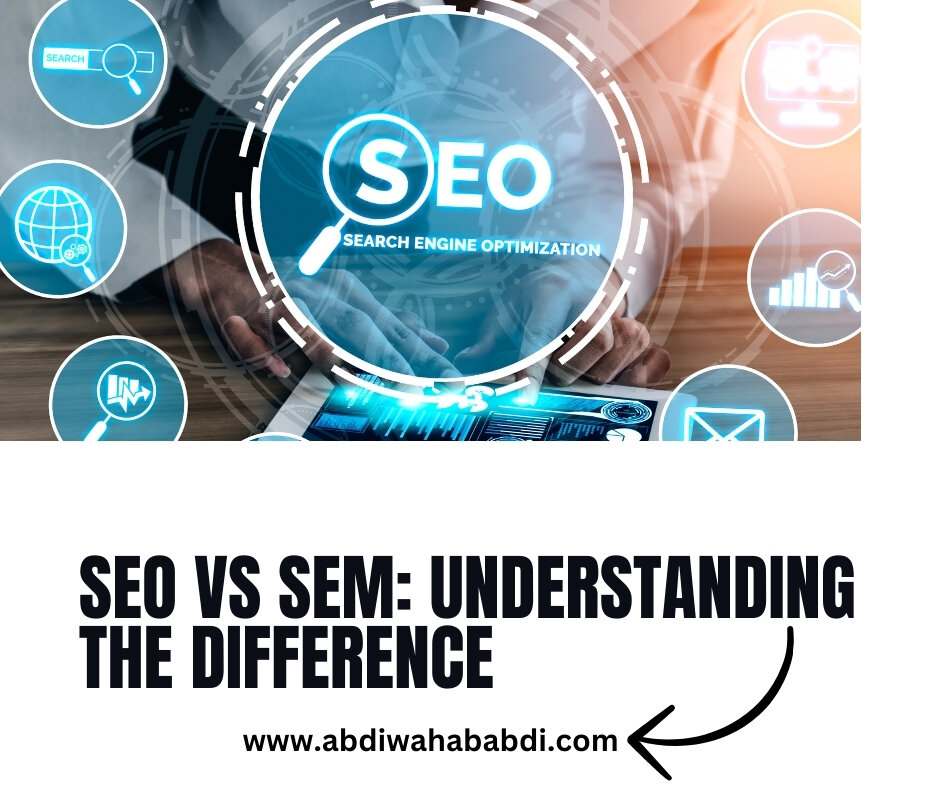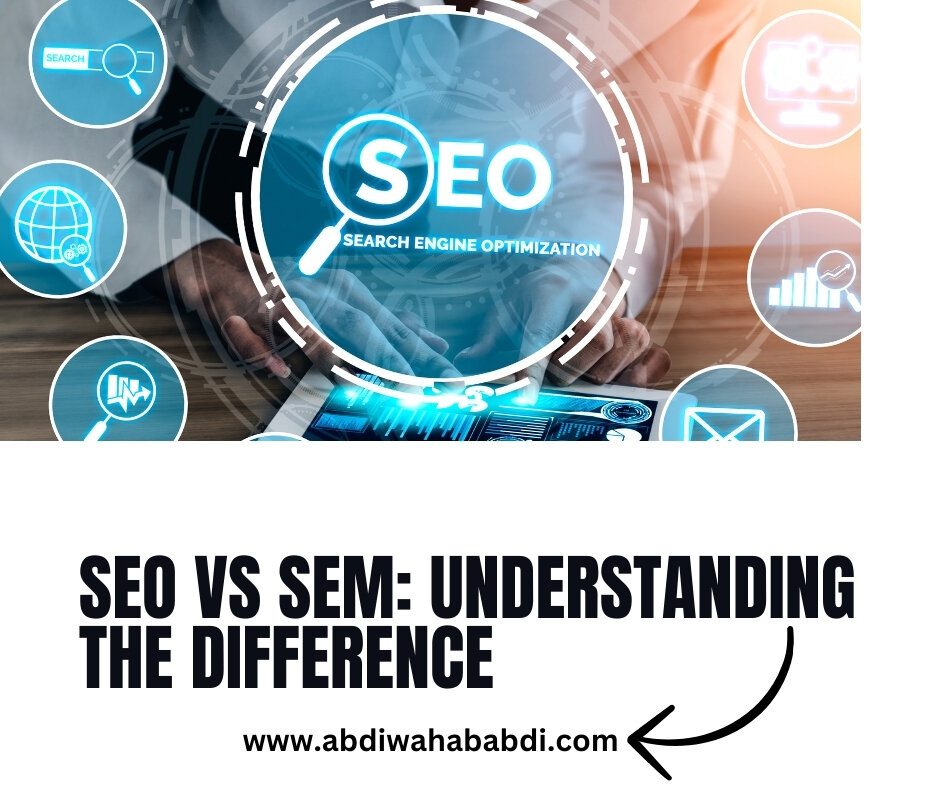SEO vs. SEM

SEO vs. SEM: Understanding the Key Differences and How They Work Together
SEO vs. SEM: Understanding the Key Differences and How They Work Together In the digital marketing world, SEO (Search Engine Optimization) and SEM (Search Engine Marketing) are two critical strategies that businesses use to enhance their online visibility and attract more customers. While they are often mentioned together and sometimes confused with each other, they serve distinct purposes and can complement each other effectively. This guide will delve into the differences between SEO and SEM, their unique benefits, and how they can be integrated to form a powerful online marketing strategy.
What is SEO?
Search Engine Optimization (SEO) is the process of optimizing your website and content to rank higher in organic (non-paid) search engine results. The primary goal of SEO is to increase the quantity and quality of traffic to your website through search engines like Google, Bing, and Yahoo.
Key Components of SEO:
- On-Page SEO:
- Content Quality: Creating high-quality, relevant content that addresses the needs and interests of your audience.
- Keyword Optimization: Identifying and using relevant keywords strategically within your content.
- Meta Tags and Descriptions: Writing compelling meta titles and descriptions that encourage clicks from search engine results.
- Header Tags: Structuring your content with H1, H2, and H3 tags to enhance readability and SEO.
- Internal Linking: Linking to other relevant pages within your site to improve navigation and distribute ranking power.
- Off-Page SEO:
- Backlinks: Acquiring links from other reputable websites, which act as endorsements for your content.
- Social Signals: Leveraging social media to drive traffic and build brand awareness, indirectly influencing SEO.
- Technical SEO:
- Site Speed: Ensuring fast loading times to enhance user experience and search rankings.
- Mobile-Friendliness: Optimizing your site for mobile devices, as mobile search traffic is significant.
- Secure Sockets Layer (SSL): Using HTTPS to secure your website and improve trustworthiness.
- Crawlability: Make sure search engines can easily index your site by improving site structure and using XML sitemaps.
SEO vs. SEM
What is SEM?
Search Engine Marketing (SEM) encompasses all the strategies used to promote your website in search engine results pages (SERPs), including both paid and organic tactics. However, SEM is often used specifically to refer to paid search advertising, such as pay-per-click (PPC) ads.
Key Components of SEM:
- Paid Search Advertising (PPC):
- AdWords and Bing Ads: Creating and managing ads on platforms like Google AdWords and Bing Ads to appear in sponsored sections of search results.
- Keyword Bidding: Selecting and bidding on keywords that potential customers are likely to use when searching for products or services.
- Ad Copy: Write compelling ad copy that entices users to click on your ads.
- Landing Pages: Creating optimized landing pages that align with your ads and drive conversions.
- Display Advertising:
- Banner Ads: Placing visual ads on websites within Google’s Display Network to reach a broader audience.
- Retargeting: Showing ads to users who have previously visited your website, encouraging them to return and convert.
- Campaign Management:
- Budget Management: Allocating and managing your ad spend to maximize return on investment (ROI).
- Performance Tracking: Analyzing ad performance through metrics like click-through rates (CTR), cost-per-click (CPC), and conversion rates.
SEO vs. SEM
Key Differences Between SEO and SEM
**1. *Cost Structure:*
- SEO: Generally involves upfront and ongoing costs related to content creation, optimization, and technical improvements, but there are no direct costs per visitor.
- SEM: Involves paying for each click or impression of your ads, making it a continuous cost as long as your ads are running.
**2. *Time Frame:*
- SEO: Typically takes longer to show results as it involves building credibility and rankings over time. It’s a long-term strategy that can yield sustainable traffic growth.
- SEM: Provides immediate visibility and traffic as soon as your ads are live, making it an effective short-term strategy for quick results.
**3. *Visibility:*
- SEO: Focuses on achieving higher organic rankings, which can lead to more clicks and credibility since users often trust organic results more than ads.
- SEM: Ensures visibility in the paid sections of search results, which can be particularly beneficial for highly competitive keywords.
**4. *Click-Through Rates (CTR):*
- SEO: Generally has a higher CTR since organic listings are often perceived as more trustworthy by users.
- SEM: This may have lower CTR but can drive highly targeted traffic and conversions, especially for transactional searches.
**5. *Longevity:*
- SEO: Once established, can provide lasting benefits without additional costs, although ongoing efforts are required to maintain rankings.
- SEM: Only drives traffic as long as you continue to pay for ads; once the budget is exhausted, the visibility ceases.
How SEO and SEM Work Together

SEO vs. SEM
While SEO and SEM have distinct roles, they can be combined to create a comprehensive and effective digital marketing strategy. Here’s how they complement each other:
**1. *Data and Insights:*
- SEM campaigns can provide valuable keyword data and insights into which terms convert best, which can inform and enhance your SEO strategy.
- Conversely, successful SEO efforts can reduce the cost of SEM campaigns by improving quality scores and lowering bid prices for keywords.
**2. *Visibility and Brand Awareness:*
- Using both SEO and SEM ensures your business is visible in both organic and paid search results, maximizing your overall presence in SERPs.
- This dual approach can reinforce brand awareness and trust, as users see your brand in multiple contexts.
**3. *Flexibility and Coverage:*
- SEO provides long-term, sustainable traffic and is especially effective for content marketing and informational searches.
- SEM allows for flexible budget allocation and immediate visibility, making it ideal for promotions, new product launches, or competitive keywords where organic rankings are challenging to achieve.
**4. *Testing and Optimization:*
- SEM allows for quick testing of ad copy, landing pages, and keywords. The insights gained can be applied to refine SEO strategies.
- SEO’s organic focus on content and user experience can enhance the effectiveness of SEM campaigns by ensuring landing pages are relevant and engaging.
SEO vs. SEM

Conclusion
SEO and SEM are both essential components of a robust digital marketing strategy. While they operate differently and have unique advantages, they are most effective when used together. SEO builds a strong foundation of organic visibility and credibility, while SEM offers immediate, targeted traffic and flexibility. By leveraging the strengths of both SEO and SEM, businesses can achieve comprehensive online visibility, attract more qualified traffic, and ultimately drive greater success in the digital landscape.



